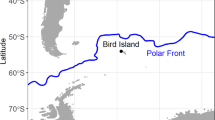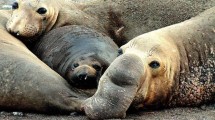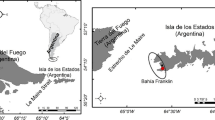Abstract
To determine whether loggerhead turtles (Caretta caretta) nesting in southeastern USA exhibit polymorphic foraging strategies, we evaluated skin samples for stable isotopes of carbon (δ13C) and nitrogen (δ15N) from 310 loggerheads from four locations on the east coast of Florida and epibionts from 48 loggerheads. We found a dichotomy between a depleted δ13C cluster and an enriched δ13C cluster. Epibionts from oceanic/pelagic or neritic/benthic habitats were largely consistent with this dichotomy. The bimodal distribution of δ13C could reflect a bimodal foraging strategy or—because of the potential for confounding among four gradients of δ13C in marine environments—a polymodal foraging strategy. We integrate our results with results from other stable isotope studies, satellite telemetry, and flipper tags to evaluate potential foraging strategies. Understanding foraging strategies is essential for development of management plans for this endangered species that has suffered a 43% population decline over the last decade.





Similar content being viewed by others
References
Abreu-Grobois A, Horrocks J, Formia A, Dutton P, LeRoux R, Vélez-Zuazo X, Soares L, Meylan P (2006) New mtDNA Dloop primers which work for a variety of marine turtle species may increase the resolution of mixed stock analyses. In: Frick M, Panagopoulou A, Rees AF, Williams K (compilers) Book of Abstracts. Twenty Sixth Annual Symposium on Sea Turtle Biology and Conservation. International Sea Turtle Society, Athens, Greece, pp 179
Aoki M (1997) Comparative study of mother-young association in caprellid amphipods: is maternal care effective? J Crust Biol 17:447–458
Bjorndal KA (1997) Foraging ecology and nutrition of sea turtles. In: Lutz PL, Musick JA (eds) The biology of sea turtles. CRC Press, Boca Raton, pp 199–231
Bjorndal KA (2003) Roles of loggerhead sea turtles in marine ecosystems. In: Bolten AB, Witherington BE (eds) Loggerhead sea turtles. Smithsonian Institution Press, Washington DC, pp 235–254
Bjorndal KA, Bolten AB (2008) Annual variation in source contributions to a mixed stock: implications for quantifying connectivity. Mol Ecol 17:2185–2193
Bjorndal KA, Meylan AB, Turner BJ (1983) Sea turtles nesting at Melbourne Beach, Florida, 1. Size, growth and reproductive biology. Biol Conserv 26:65–77
Bjorndal KA, Bolten AB, Martins HR (2000) Somatic growth model of juvenile loggerhead sea turtles Caretta caretta: duration of pelagic stage. Mar Ecol Prog Ser 202:265–272
Bjorndal KA, Bolten AB, Dellinger T, Delgado C, Martins HR (2003) Compensatory growth in oceanic loggerhead sea turtles: response to a stochastic environment. Ecology 84:1237–1249
Bolten AB (2003) Active swimmers—passive drifters: the oceanic juvenile stage of loggerheads in the Atlantic system. In: Bolten AB, Witherington BE (eds) Loggerhead sea turtles. Smithsonian Institution Press, Washington DC, pp 63–78
Carr A (1986) Rips, FADS, and little loggerheads. Bioscience 36:92–100
Chace FA (1951) The oceanic crabs of the genera Planes and Pachygrapus. Proc US Natl Mus 101:65–103
Dodd CK Jr, Byles R (2003) Post-nesting movements and behavior of loggerhead sea turtles (Caretta caretta) departing from east-central Florida nesting beaches. Chelonian Conserv Biol 4:530–536
Eckert SA, Martins HR (1989) Transatlantic travel by juvenile loggerhead turtle. Mar Turt Newsl 45:15
Ehrhart LM, Bagley DA, Redfoot WE (2003) Loggerhead turtles in the Atlantic Ocean: geographic distribution, abundance, and population status. In: Bolten AB, Witherington BE (eds) Loggerhead sea turtles. Smithsonian Institution Press, Washington DC, pp 157–174
Foley AM, Schroeder BA, MacPherson SL (2008) Post-nesting migrations and resident areas of Florida loggerheads. In: Kalb H, Rohde A, Gayheart K and Shanker K (compilers) Proceedings of the Twenty-fifth Annual Symposium on Sea Turtle Biology and Conservation. NOAA Tech Mem NMFS-SEFSC-582
Foster JM, Thoma BP, Heard RM (2004) Range extensions and review of the caprellid amphipods (Crustacea: Amphipoda: Caprellidae) from the shallow, coastal waters from the Suwannee River, Florida, to Port Aransas, Texas, with an illustrated key. Gulf Carib Res 16:161–175
France RL (1995) Carbon-13 enrichment in benthic compared to planktonic algae: foodweb implications. Mar Ecol Prog Ser 124:307–312
Frick MG, Williams KL, Robinson M (1998) Epibionts associated with nesting loggerhead sea turtles (Caretta caretta) in Georgia, USA. Herpetol Rev 29:211–214
Frick MG, Ross A, Williams KL, Bolten AB, Bjorndal KA, Martins HR (2003) Epibiotic associates of oceanic-stage loggerhead turtles from the southeastern North Atlantic. Mar Turt Newsl 101:18–20
Frick MG, Ross A, Williams KL, Bolten AB, Bjorndal KA, Martins HR (2004) Diet and fecundity of Columbus crabs, Planes minutus, associated with oceanic-stage loggerhead sea turtles, Caretta caretta, and inanimate flotsam. J Crust Biol 24:350–355
Frick MG, Williams KL, Bresette M, Singewald DA, Herren RM (2006) On the occurrence of Columbus crabs (Planes minutus) from loggerhead turtles in Florida, USA. Mar Turt Newsl 114:12–14
Frick MG, Williams KL, Bolten AB, Bjorndal KB, Martins HR (2009) Foraging ecology of oceanic-stage loggerhead turtles (Caretta caretta), opportunistic carnivores. Endang Species Res (in press)
Goericke R, Fry B (1994) Variations in marine plankton d13C with latitude, temperature, and dissolved CO2 in the world ocean. Global Biogeochem Cycles 8:85–90
Guseman JL, Ehrhart LM (1992) A contribution to the ecologic geography of the western Atlantic loggerhead and green turtle from analysis of remote tag recoveries. Fla Sci 55(Suppl 1):24–25
Hatase H, Takai N, Matsuzawa Y, Sakamoto W, Omuta K, Goto K, Arai N, Fujiwara T (2002) Size-related differences in feeding habitat use of adult female loggerhead turtles Caretta caretta around Japan determined by stable isotope analyses and satellite telemetry. Mar Ecol Prog Ser 233:273–281
Hatase H, Matsuzawa Y, Sato K, Bando T, Goto K (2004) Remigration and growth of loggerhead turtles (Caretta caretta) nesting on Senri Beach in Minabe, Japan: life-history polymorphism in a sea turtle population. Mar Biol 144:807–811
Hawkes LA, Broderick AC, Coyne MS, Godfrey MS, Lopez-Jurado LF, Lopez-Suarez P, Merino SE, Varo-Cruz N, Godley BJ (2006) Phenotypically linked dichotomy in sea turtle foraging requires multiple conservation approaches. Curr Biol 16:990–995
Hobson KA, Schell DM (1998) Stable carbon and nitrogen isotope patterns in baleen from eastern Arctic bowhead whales (Balaena mysticetus). Can J Fish Aquat Sci 55:2601–2607
Hobson KA, Piatt JF, Pitocchelli J (1994) Using stable isotopes to determine seabird trophic relationships. J Anim Ecol 63:786–798
Insightful Corporation (2001) S-plus 6 for windows: guide to statistics, vol 2. Insightful Corporation, Seattle
IUCN (2009) IUCN Red List of Threatened Species, version 2009.1 http://www.iucnredlist.org. Accessed 7 Aug 2009
Kaufman L, Rousseeuw PJ (1990) Finding groups in data: an introduction to cluster analysis. Wiley, New York
Lajtha K, Michener RH (1994) Stable isotopes in ecology and environmental science. Blackwell, Oxford
Lorian D, Erez J, Lazar B (1992) Stable carbon isotopes in the reef ecosystem of the Gulf of Eliat—Red Sea. In: Richmond RH (ed) Proceedings of 7th international coral reef Symposium. University of Guam, Mangilao, Guam, p 364 (Cited in: Achituv Y, Brickner L, Erez J (1997) Stable carbon isotope ratios in Red Sea barnacles (Cirripedia) as an indicator of their food source. Mar Biol 130:243–247)
Macko SA, Estep MLF, Engel MH, Hare PE (1986) Kinetic fractionation of stable isotopes during amino-acid transamination. Geochim Cosmochim Acta 50:2143–2146
Martínez del Rio C, Wolf N, Carleton SA, Gannes LZ (2009) Isotopic ecology ten years after a call for more laboratory experiments. Biol Rev 84:91–111
McCain JC (1968) The Caprellidae (Crustacea: Amphipoda) of the western North Atlantic. Bull US Natl Mus 278:1–147
McClellan CM, Read AJ (2007) Complexity and variation in loggerhead sea turtle life history. Biol Lett 3:592–594
Meylan A (1982) Sea turtle migration—evidence from tag returns. In: Bjorndal KA (ed) Biology and conservation of sea turtles. Smithsonian Institution Press, Washington DC, pp 91–100
Meylan AB, Bjorndal KA, Turner BJ (1983) Sea turtles nesting at Melbourne Beach, Florida, 2. Post-nesting movements of Caretta caretta. Biol Conserv 26:79–90
Michener RH, Kaufman L (2007) Stable isotope ratios as tracers in marine food webs: an update. In: Michener RH, Lajtha K (eds) Stable isotopes in ecology and environmental science, 2nd edn. Blackwell, Oxford, pp 238–282
Michener RH, Lajtha K (2007) Stable isotopes in ecology and environmental science, 2nd edn. Blackwell, Oxford
Minagawa M, Wada E (1984) Stepwise enrichment of 15N along food chains: further evidence and the relation between 15N and animal age. Geochim Cosmochim Acta 48:1135–1140
National Marine Fisheries Service, U.S. Fish and Wildlife Service (1991) Recovery plan for U.S. population of loggerhead turtle, Caretta caretta. National Marine Fisheries Service, Washington DC
National Marine Fisheries Service, U.S. Fish and Wildlife Service (2008) Recovery plan for the Northwest Atlantic population of the loggerhead sea turtle (Caretta caretta), second revision. National Marine Fisheries Service, Silver Spring
Newsome SD, Martínez del Rio C, Bearhop S, Phillips DL (2007) A niche for isotopic ecology. Front Ecol Environ 5:429–436
Pfaller JB, Frick MG, Reich KJ, Williams KL, Bjorndal KA (2008) Carapace epibionts of loggerhead turtles (Caretta caretta) nesting at Canaveral National Seashore, Florida. J Nat Hist 42:1095–1102
Reich KJ, Bjorndal KA, Bolten AB (2007) The “lost years” of green turtles: using stable isotopes to study cryptic lifestages. Biol Lett 3:712–714
Reich KJ, Bjorndal KA, Martínez del Rio C (2008) Effects of growth and tissue type on the kinetics of 13C and 15N incorporation in a rapidly growing ectotherm. Oecologia 155:651–663
Rubenstein DR, Hobson KA (2004) From birds to butterflies: animal movement patterns and stable isotopes. Trends Ecol Evol 19:256–263
Seney EE, Musick JA (2007) Historical diet analysis of loggerhead sea turtles (Caretta caretta) in Virginia. Copeia 2007:478–489
Turtle Expert Working Group (2009) An assessment of the loggerhead turtle population in the western North Atlantic Ocean. NOAA Tech Mem NMFS-SEFSC-575
Venables WN, Ripley BD (1999) Modern applied statistics with S-plus, 3rd edn. Springer, Oxford
Wallace BP, Avens L, Braun-McNeill J, McClellan CM (2009) The diet composition of immature loggerheads: insights on trophic niche, growth rates, and fisheries interactions. J Exp Mar Biol Ecol 373:50–57
Williams AB (1984) Shrimps, lobsters and crabs of the Atlantic coast of the eastern United States, Maine to Florida. Smithsonian Institution Press, Washington DC 550 pp
Witherington BE (2002) Ecology of neonate loggerhead turtles inhabiting lines of downwelling near a Gulf Stream front. Mar Biol 140:843–853
Witherington B, Kubilis P, Brost B, Meylan A (2009) Decreasing annual nest counts in a globally important loggerhead sea turtle population. Ecol Appl 19:30–54
Wunder MB, Kester CL, Knopf FL, Rye R (2005) A test of geographic assignment using isotope tracers in feathers of known origin. Oecologia 144:607–617
Zaykin DV, Pudovkin AI (1993) Two programs to estimate chi square values using pseudo-probability test. J Hered 84:152
Acknowledgments
This study was funded by National Marine Fisheries Service, U.S. Fish and Wildlife Service, Disney Worldwide Conservation Fund, FWC Marine Turtle Grants Program, Florida’s Marine Turtle Protection Trust Fund, Cape Canaveral National Seashore, and the Knight Vision Foundation and Keir Kleinknecht. This research was conducted in compliance with the Institutional Animal Care and Use Committee of the University of Florida (Protocol #D-093), Florida Fish and Wildlife Conservation Commission (sea turtle permit #TP-016), and U.S. Department of the Interior, National Park Service (Scientific Research and Collecting Permits CANA-2003-SCI-0008; CANA-2004-SCI-0003). The PADI Foundation provided the microscopy equipment used for epibiont analyses. We thank J. Stiner for providing housing and field assistance at Cape Canaveral National Seashore, L. Ehrhart and L. Fisher for providing access to their study sites, J. Curtis for assistance with stable isotope analysis, J. Pfaller for his help with identification of epibionts, and B. Wallace for providing North Carolina stable isotope data. We also thank T. Hirama, N. Osman, T. Garcia, C. King, and K. Martin for their help in the field, P. Eliazar and K. L. Williams for their invaluable assistance, and three anonymous reviewers for their comments.
Author information
Authors and Affiliations
Corresponding author
Additional information
Communicated by R. Lewison.
Rights and permissions
About this article
Cite this article
Reich, K.J., Bjorndal, K.A., Frick, M.G. et al. Polymodal foraging in adult female loggerheads (Caretta caretta). Mar Biol 157, 113–121 (2010). https://doi.org/10.1007/s00227-009-1300-4
Received:
Accepted:
Published:
Issue Date:
DOI: https://doi.org/10.1007/s00227-009-1300-4




